HMCA-Contour: A Visual Basic Program Based on Surfer Automation for Soil Heavy Metal Spatial Distribution and Contamination Assessment Mapping
Abstract
:1. Introduction
2. Methodology
2.1. Geo-Accumulation Index
2.2. Pollution Load Index
2.3. Enrichment Factor Index
2.4. Ecological Risk Index
2.5. Single and Nemero Pollution Index
3. Software Description
3.1. Software Operation Environment Requirements
3.2. Data Processing Feature
3.2.1. Data Input
3.2.2. Data Processing
3.3. Batch Plotting Function
3.3.1. Data Input
3.3.2. Plotting
3.3.3. Gridding Method Descriptions
3.4. Template Setting
3.4.1. Color Scale
3.4.2. Axis Ticks
3.4.3. Axis Titles
3.4.4. Axis Labels
3.4.5. Map Title, Scale Bar, and North Arrow
4. Case Study
4.1. Study Area and Data
4.2. Pollution Indices Calculation
4.3. Spatial Distribution of Heavy Metal Concentrations
4.4. Heavy Metal Contamination Assessment Maps
5. Conclusions
Author Contributions
Funding
Data Availability Statement
Acknowledgments
Conflicts of Interest
References
- Khan, K.; Lu, Y.; Khan, H.; Ishtiaq, M.; Khan, S.; Waqas, M.; Wei, L.; Wang, T. Heavy metals in agricultural soils and crops and their health risks in Swat District, northern Pakistan. Food Chem. Toxicol. 2013, 58, 449–458. [Google Scholar] [CrossRef]
- Fei, X.; Christakos, G.; Xiao, R.; Ren, Z.; Liu, Y.; Lv, X. Improved heavy metal mapping and pollution source apportionment in Shanghai City soils using auxiliary information. Sci. Total Environ. 2019, 661, 168–177. [Google Scholar] [CrossRef]
- Gobran, G.R.; Huang, P. Biogeochemistry of Trace Elements in the Rhizosphere, 1st ed.; Elsevier: Amsterdam, The Netherlands, 2005; pp. 1–182. [Google Scholar]
- Noll, M.R. Trace elements in terrestrial environments: Biogeochemistry, bioavailability, and risks of metals. J. Environ. Qual. 2003, 32, 374. [Google Scholar] [CrossRef]
- Liu, G.; Wang, J.; Liu, X.; Liu, X.; Li, X.; Ren, Y.; Wang, J.; Dong, L. Partitioning and geochemical fractions of heavy metals from geogenic and anthropogenic sources in various soil particle size fractions. Geoderma 2018, 312, 104–113. [Google Scholar] [CrossRef]
- Liu, G.; Xue, W.; Wang, J.; Liu, X. Transport behavior of variable charge soil particle size fractions and their influence on cadmium transport in saturated porous media. Geoderma 2019, 337, 945–955. [Google Scholar] [CrossRef]
- Bai, J.; Cui, B.; Chen, B.; Zhang, K.; Deng, W.; Gao, H.; Xiao, R. Spatial distribution and ecological risk assessment of heavy metals in surface sediments from a typical plateau lake wetland, China. Ecol. Model. 2011, 222, 301–306. [Google Scholar] [CrossRef]
- Xie, Y.; Chen, T.B.; Lei, M.; Yang, J.; Guo, Q.J.; Song, B.; Zhou, X.Y. Spatial distribution of soil heavy metal pollution estimated by different interpolation methods: Accuracy and uncertainty analysis. Chemosphere 2011, 82, 468–476. [Google Scholar] [CrossRef] [PubMed]
- Tóth, G.; Hermann, T.; Szatmári, G.; Pásztor, L. Maps of heavy metals in the soils of the European Union and proposed priority areas for detailed assessment. Sci. Total Environ. 2016, 565, 1054–1062. [Google Scholar] [CrossRef] [PubMed]
- Liu, G.; Yu, Y.; Hou, J.; Xue, W.; Liu, X.; Liu, Y.; Wang, W.; Alsaedi, A.; Hayat, T.; Liu, Z. An ecological risk assessment of heavy metal pollution of the agricultural ecosystem near a lead-acid battery factory. Ecol. Indic. 2014, 47, 210–218. [Google Scholar] [CrossRef]
- Sutkowska, K.; Teper, L.; Czech, T.; Hulok, T.; Olszak, M.; Zogala, J. Quality of peri-urban soil developed from ore-bearing carbonates: Heavy metal levels and source apportionment assessed using pollution indices. Minerals 2020, 10, 1140. [Google Scholar] [CrossRef]
- Müller, G. Index of geoaccumulation in sediments of the Rhine River. Geojournal 1969, 2, 108–118. [Google Scholar]
- Tomlinson, D.L.; Wilson, J.G.; Harris, C.R.; Jeffrey, D.W. Problems in the assessment of heavy-metal levels in estuaries and the formation of a pollution index. Helgoländer Meeresunters. 1980, 33, 566–575. [Google Scholar] [CrossRef] [Green Version]
- Covelli, S.; Fontolan, G. Application of a normalization procedure in determining regional geochemical baselines. Environ. Geol. 1997, 30, 34–45. [Google Scholar] [CrossRef]
- Hakanson, L. An ecological risk index for aquatic pollution control.a sedimentological approach. Water Res. 1980, 14, 975–1001. [Google Scholar] [CrossRef]
- Wang, X.; Dan, Z.; Cui, X.; Zhang, R.; Zhou, S.; Wenga, T.; Yan, B.; Chen, G.; Zhang, Q.; Zhong, L. Contamination, ecological and health risks of trace elements in soil of landfill and geothermal sites in Tibet. Sci. Total Environ. 2020, 715, 136639. [Google Scholar] [CrossRef] [PubMed]
- Zhen, J.; Pei, T.; Xie, S. Kriging methods with auxiliary nighttime lights data to detect potentially toxic metals concentrations in soil. Sci. Total Environ. 2019, 659, 363–371. [Google Scholar] [CrossRef] [PubMed]
- Petrik, A.; Thiombane, M.; Lima, A.; Albanese, S.; Buscher, J.T.; De Vivo, B. Soil contamination compositional index: A new approach to quantify contamination demonstrated by assessing compositional source patterns of potentially toxic elements in the Campania Region (Italy). Appl. Geochem. 2018, 96, 264–276. [Google Scholar] [CrossRef]
- Yan, W.; Mahmood, Q.; Peng, D.; Fu, W.; Chen, T.; Wang, Y.; Li, S.; Chen, J.; Liu, D. The spatial distribution pattern of heavy metals and risk assessment of moso bamboo forest soil around lead–zinc mine in Southeastern China. Soil Tillage Res. 2015, 153, 120–130. [Google Scholar] [CrossRef]
- Jiang, X.; Zou, B.; Feng, H.; Tang, J.; Tu, Y.; Zhao, X. Spatial distribution mapping of Hg contamination in subclass agricultural soils using GIS enhanced multiple linear regression. J. Geochem. Explor. 2019, 196, 1–7. [Google Scholar] [CrossRef]
- Lu, A.; Wang, J.; Qin, X.; Wang, K.; Han, P.; Zhang, S. Multivariate and geostatistical analyses of the spatial distribution and origin of heavy metals in the agricultural soils in Shunyi, Beijing, China. Sci. Total Environ. 2012, 425, 66–74. [Google Scholar] [CrossRef]
- Wang, X.S. Assessment of heavy metal pollution in Xuzhou urban topsoils by magnetic susceptibility measurements. J. Appl. Geophys. 2013, 92, 76–83. [Google Scholar] [CrossRef]
- Zhang, Y.; Li, S.; Chen, Z.; Wang, F.; Chen, J.; Wang, L. A systemic ecological risk assessment based on spatial distribution and source apportionment in the abandoned lead acid battery plant zone, China. J. Hazard. Mater. 2018, 354, 170–179. [Google Scholar] [CrossRef] [PubMed]
- Huang, Y.; Li, T.; Wu, C.; He, Z.; Japenga, J.; Deng, M.; Yang, X. An integrated approach to assess heavy metal source apportionment in peri-urban agricultural soils. J. Hazard. Mater. 2015, 299, 540–549. [Google Scholar] [CrossRef] [PubMed]
- Wang, M.; Bai, Y.; Chen, W.; Markert, B.; Peng, C.; Ouyang, Z. A GIS technology based potential eco-risk assessment of metals in urban soils in Beijing, China. Environ. Pollut. 2012, 161, 235–242. [Google Scholar] [CrossRef]
- Gong, Q.J.; Deng, J.; Xiang, Y.C.; Wang, Q.F.; Yang, L.Q. Calculating pollution indices by heavy metals in ecological geochemistry assessment and a case study in parks of Beijing. J. China Uni. Geosci. 2008, 19, 230–241. [Google Scholar]
- Lin, J.; Yang, K.; Chen, H.; Wang, J.Y.; Zhang, C.G.; Huang, C.R. The visualization of soil moisture based on VB and Surfer. Adv. Mater. Res. 2013, 774–776, 1859–1864. [Google Scholar] [CrossRef]
- Hou, C.Q.; Li, Z.Q.; Wu, X.B. Application of VB and Surfer Automation technique in geochemical exploration. Comput. Tech. Geophys.Geochem. Explor. 2010, 32, 565–570. [Google Scholar]
- Zhang, T.J.; Wang, X.W.; Zhang, H.; Liu, X.W. Application of surfer automation technique in automatic mapping for meteorological data. Arid Meteorol. 2007, 2, 90–93. [Google Scholar]
- Ni, J.J.; Zhang, X.H. Fast visualizing of hydrological data with VB 6.0 embedded with compiler of Surfer 7.0. Hydrogr. Surv. Charting 2005, 1, 64–66. [Google Scholar]
- Loska, K.; Wiechuła, D.; Korus, I. Metal contamination of farming soils affected by industry. Environ. Int. 2004, 30, 159–165. [Google Scholar] [CrossRef]
- Zoller, W.H.; Gladney, E.; Duce, R.A. Atmospheric concentrations and sources of trace metals at the South Pole. Science 1974, 183, 198–200. [Google Scholar] [CrossRef] [PubMed]
- N’Guessan, Y.M.; Probst, J.L.; Bur, T.; Probst, A. Trace elements in stream bed sediments from agricultural catchments (Gascogne region, S-W France): Where do they come from? Sci. Total Environ. 2009, 407, 2939–2952. [Google Scholar] [CrossRef] [PubMed]
- Woitke, P.; Wellmitz, J.; Helm, D.; Kube, P.; Lepom, P.; Litheraty, P. Analysis and assessment of heavy metal pollution in suspended solids and sediments of the river Danube. Chemosphere 2003, 51, 633–642. [Google Scholar] [CrossRef]
- Sutherland, R.A. Bed sediment-associated trace metals in an urban stream, Oahu, Hawaii. Environ. Geol. 2000, 39, 611–627. [Google Scholar] [CrossRef]
- Lee, D.S.; Garland, J.A.; Fox, A.A. Atmospheric concentrations of trace elements in urban areas of the United Kingdom. Atmos. Environ. 1994, 28, 2691–2713. [Google Scholar] [CrossRef]
- Loska, K.; Cebula, J.; Pelczar, J.; Wiechuła, D.; Kwapuliński, J. Use of Enrichment, and Contamination Factors Together with Geoaccumulation Indexes to Evaluate the Content of Cd, Cu, and Ni in the Rybnik Water Reservoir in Poland. Water Air Soil Pollut. 1997, 93, 347–365. [Google Scholar] [CrossRef]
- Schiff, K.C.; Weisberg, S.B. Iron as a reference element for determining trace metal enrichment in Southern California coastal shelf sediments. Mar. Environ. Res. 1999, 48, 161–176. [Google Scholar] [CrossRef]
- Tam, N.F.Y.; Yao, M.W.Y. Normalisation and heavy metal contamination in mangrove sediments. Sci. Total Environ. 1998, 216, 33–39. [Google Scholar] [CrossRef]
- Cui, J.; Zang, S.; Zhai, D.; Wu, B. Potential ecological risk of heavy metals and metalloid in the sediments of Wuyuer River basin, Heilongjiang Province, China. Ecotoxicology 2014, 23, 589–600. [Google Scholar] [CrossRef] [PubMed]
- Jiang, H.H.; Cai, L.M.; Wen, H.H.; Hu, G.C.; Chen, L.G.; Luo, J. An integrated approach to quantifying ecological and human health risks from different sources of soil heavy metals. Sci. Total Environ. 2020, 701, 134466. [Google Scholar] [CrossRef]
- Li, L.; Wu, J.; Lu, J.; Min, X.; Xu, J.; Yang, L. Distribution, pollution, bioaccumulation, and ecological risks of trace elements in soils of the northeastern Qinghai-Tibet Plateau. Ecotox. Environ. Safe. 2018, 166, 345–353. [Google Scholar] [CrossRef] [PubMed]
- Lee, C.S.L.; Li, X.D.; Shi, W.Z.; Cheung, S.C.N.; Thornton, I. Metal contamination in urban, suburban, and country park soils of Hong Kong: A study based on GIS and multivariate statistics. Sci. Total Environ. 2006, 356, 45–61. [Google Scholar] [CrossRef] [PubMed] [Green Version]
- Nemerow, N.L. Scientific Stream Pollution Analysis, 1st ed.; Scripta Book Company: Washington, DC, USA, 1974; pp. 1–68. [Google Scholar]
- Cheng, J.L.; Shi, Z.; Zhu, Y.W. Assessment and mapping of environmental quality in agricultural soils of Zhejiang Province, China. J. Environ. Sci. 2007, 19, 50–54. [Google Scholar] [CrossRef]
- Mazurek, R.; Kowalska, J.; Gąsiorek, M.; Zadrożny, P.; Józefowska, A.; Zaleski, T.; Kępka, W.; Tymczuk, M.; Orłowska, K. Assessment of heavy metals contamination in surface layers of Roztocze National Park forest soils (SE Poland) by indices of pollution. Chemosphere 2017, 168, 839–850. [Google Scholar] [CrossRef]
- Zhou, J.; Feng, K.; Pei, Z.; Lu, M. Pollution assessment and spatial variation of soil heavy metals in Lixia River Region of Eastern China. J. Soils Sediments 2016, 16, 748–755. [Google Scholar] [CrossRef]
- Wang, Z.; Liu, X.; Qin, H. Bioconcentration and translocation of heavy metals in the soil-plants system in Machangqing copper mine, Yunnan Province, China. J. Geochem. Explor. 2019, 200, 159–166. [Google Scholar] [CrossRef]
- EPAC. The Technical Specification for Soil Environmental Monitoring; China Environmental Protection Agency: Beijing, China, 2005. [Google Scholar]
- Chen, H.H.; Li, X.; Ding, W.X. Twelve kinds of gridding methods of Surfer 8.0 in isoline drawing. Chin. J. Eng. Geophys. 2007, 4, 52–57. [Google Scholar]
- Liu, Q.P.; Deng, S.Q.; Zhao, Y.Y.; Li, X.S. Sources Analysis and Element Geochemical Characteristics of Regional Soil Heavy Metals from the Ga’erqin Ore Deposit, Tibet. Acta Geosci. Sin. 2018, 39, 481–490. [Google Scholar]
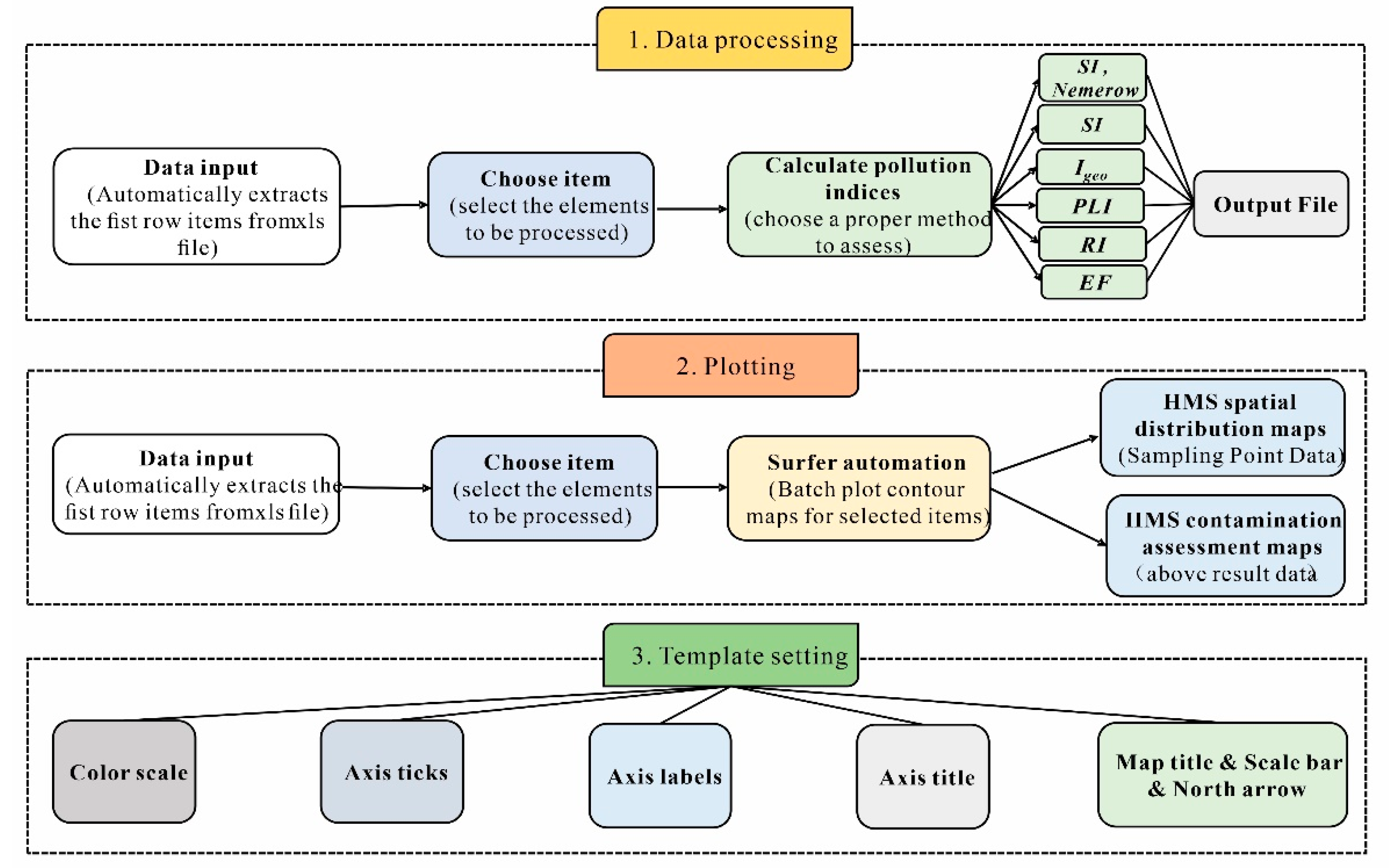
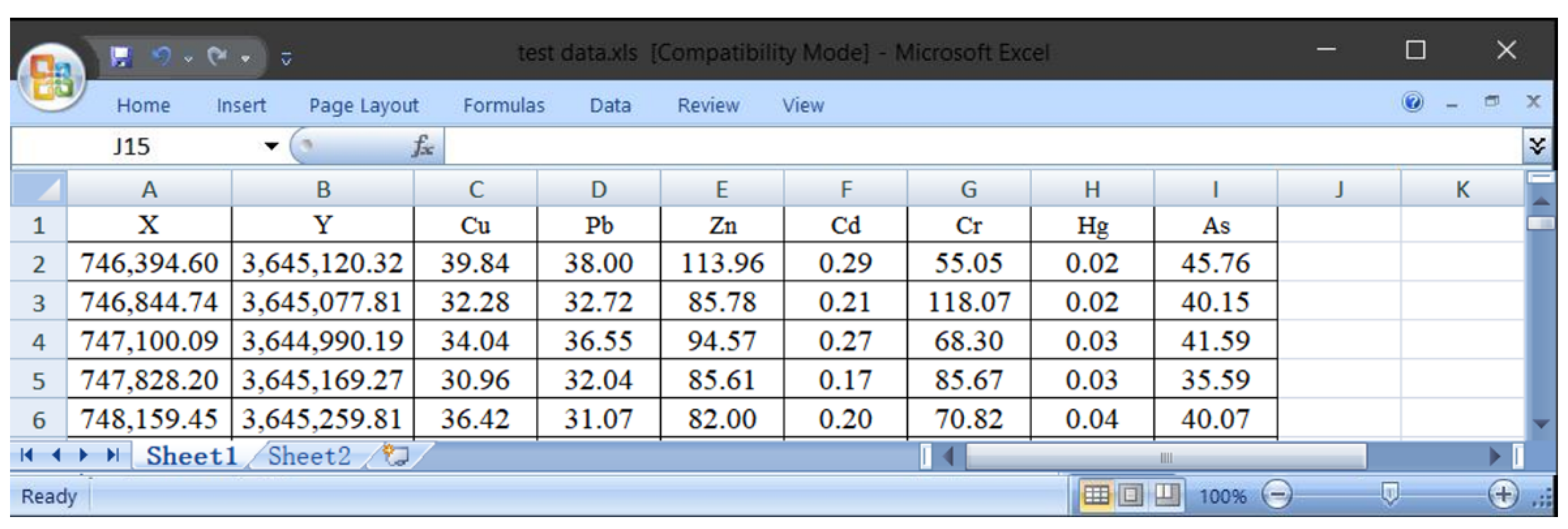
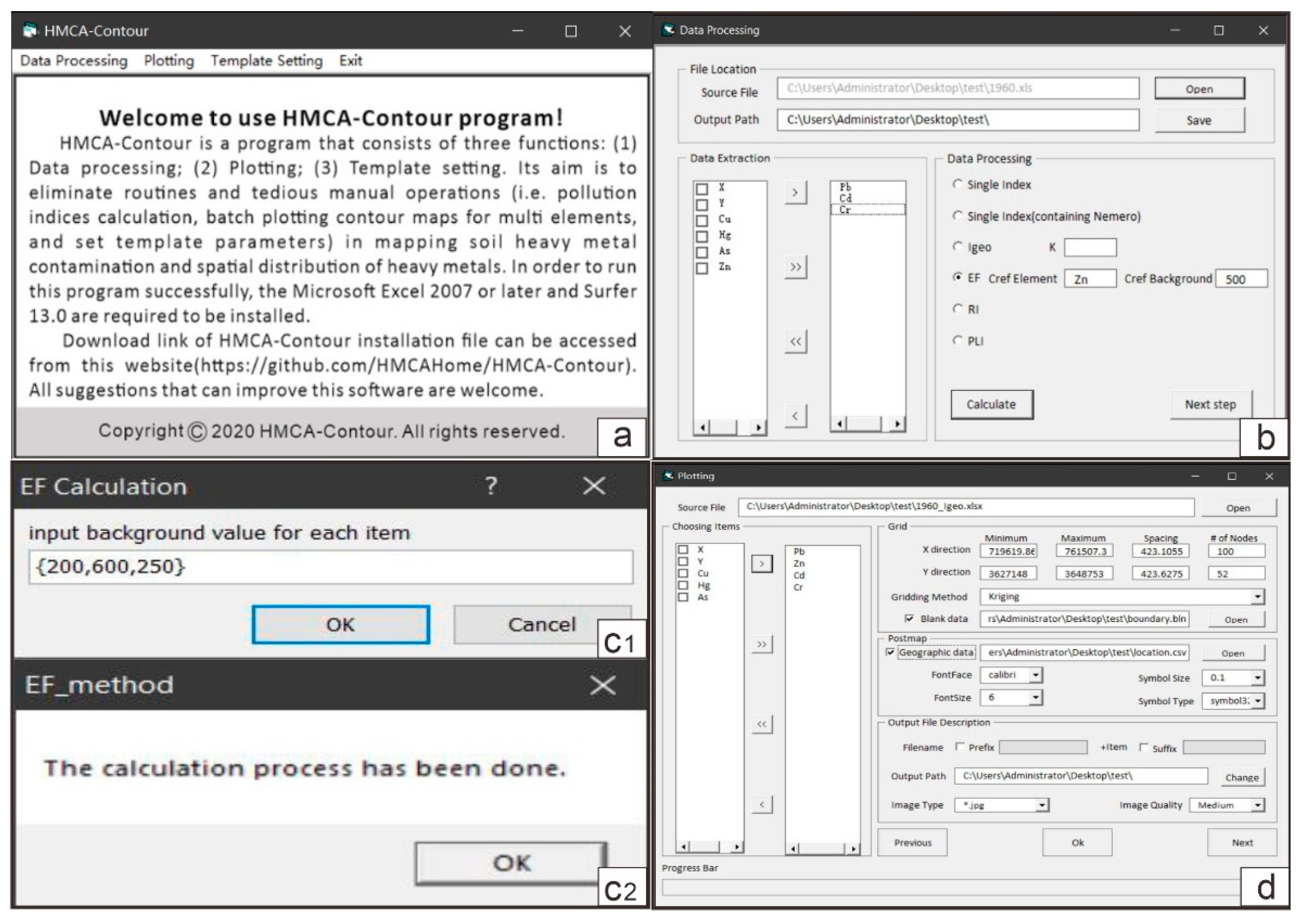
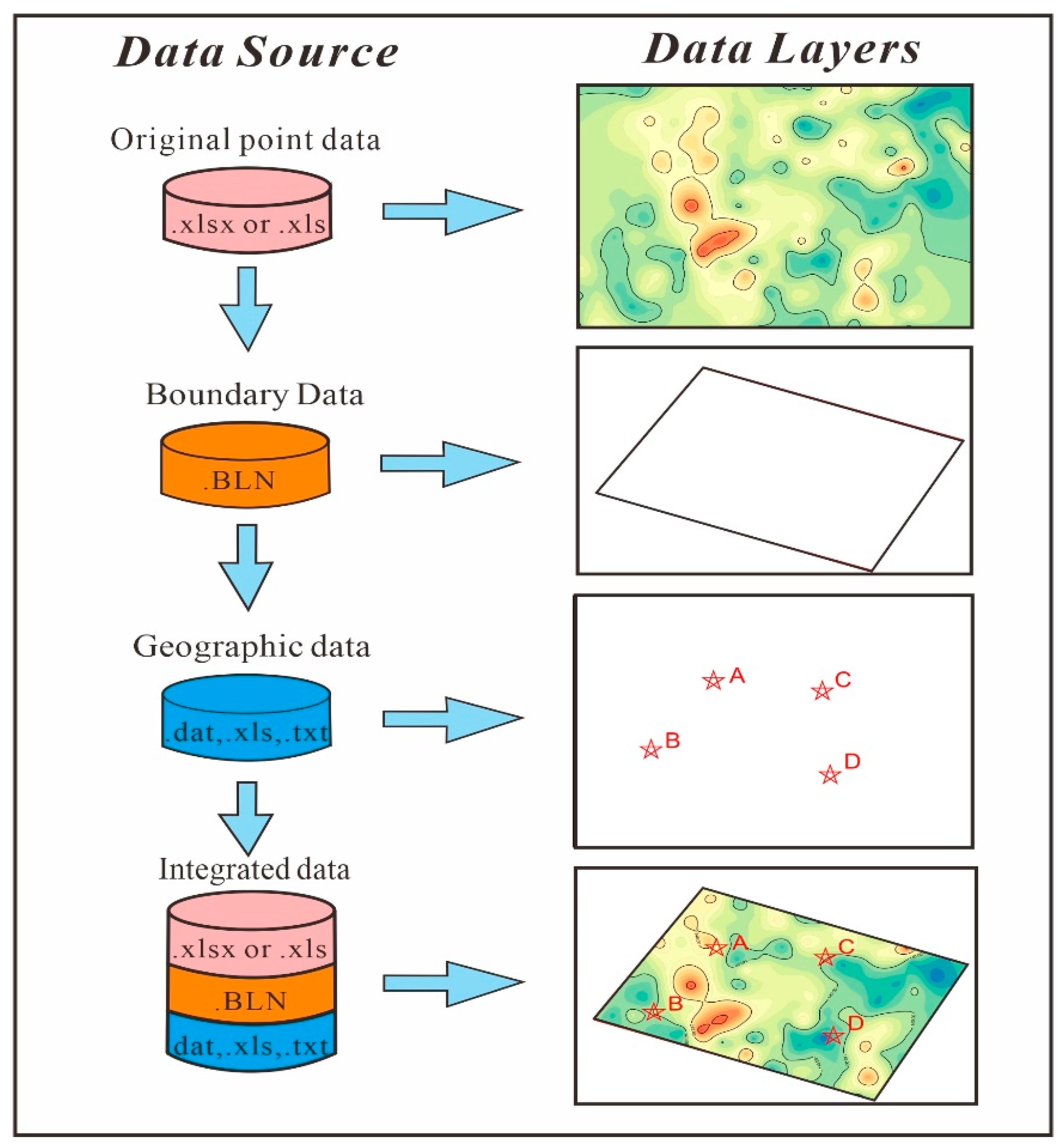
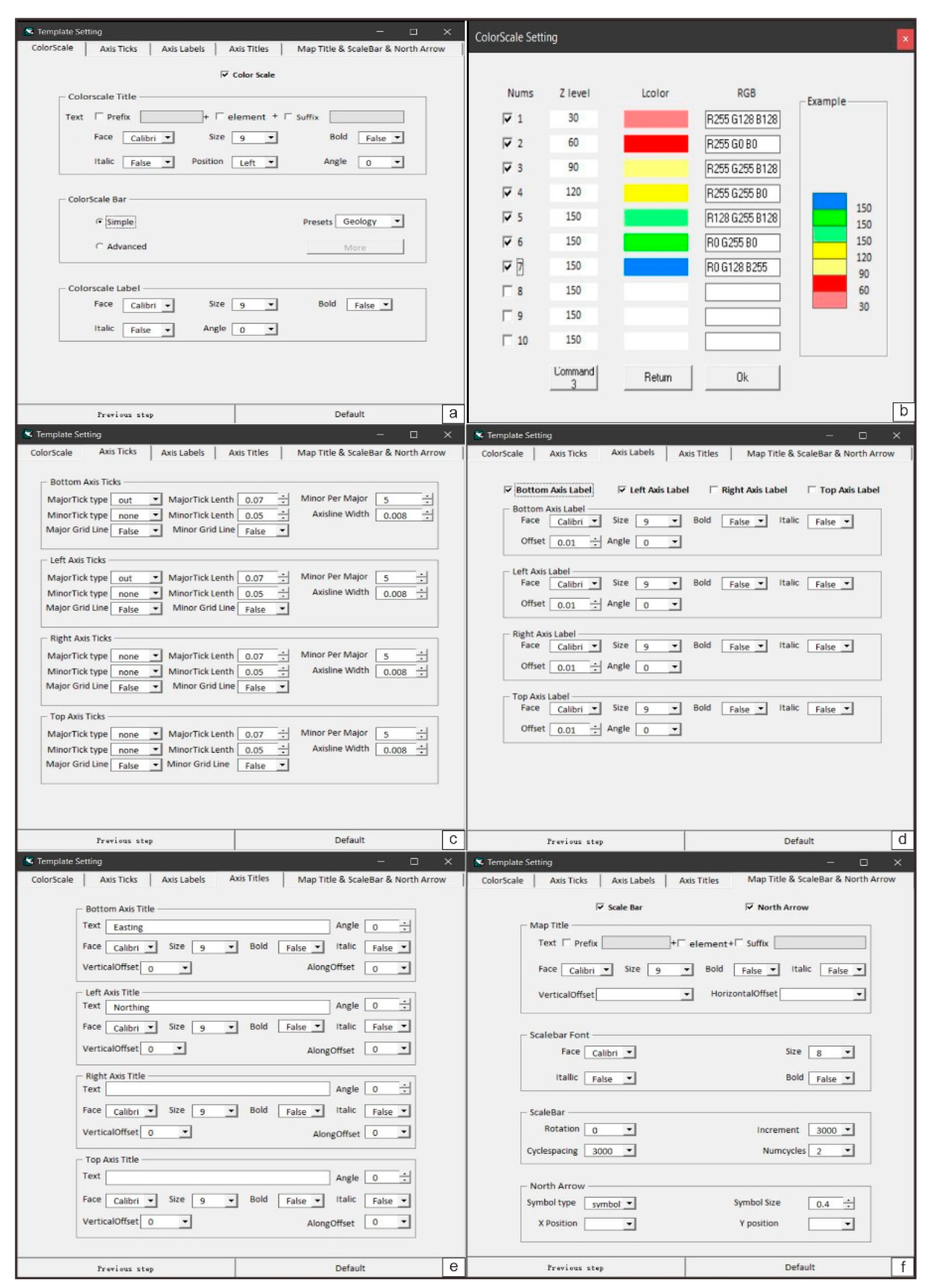

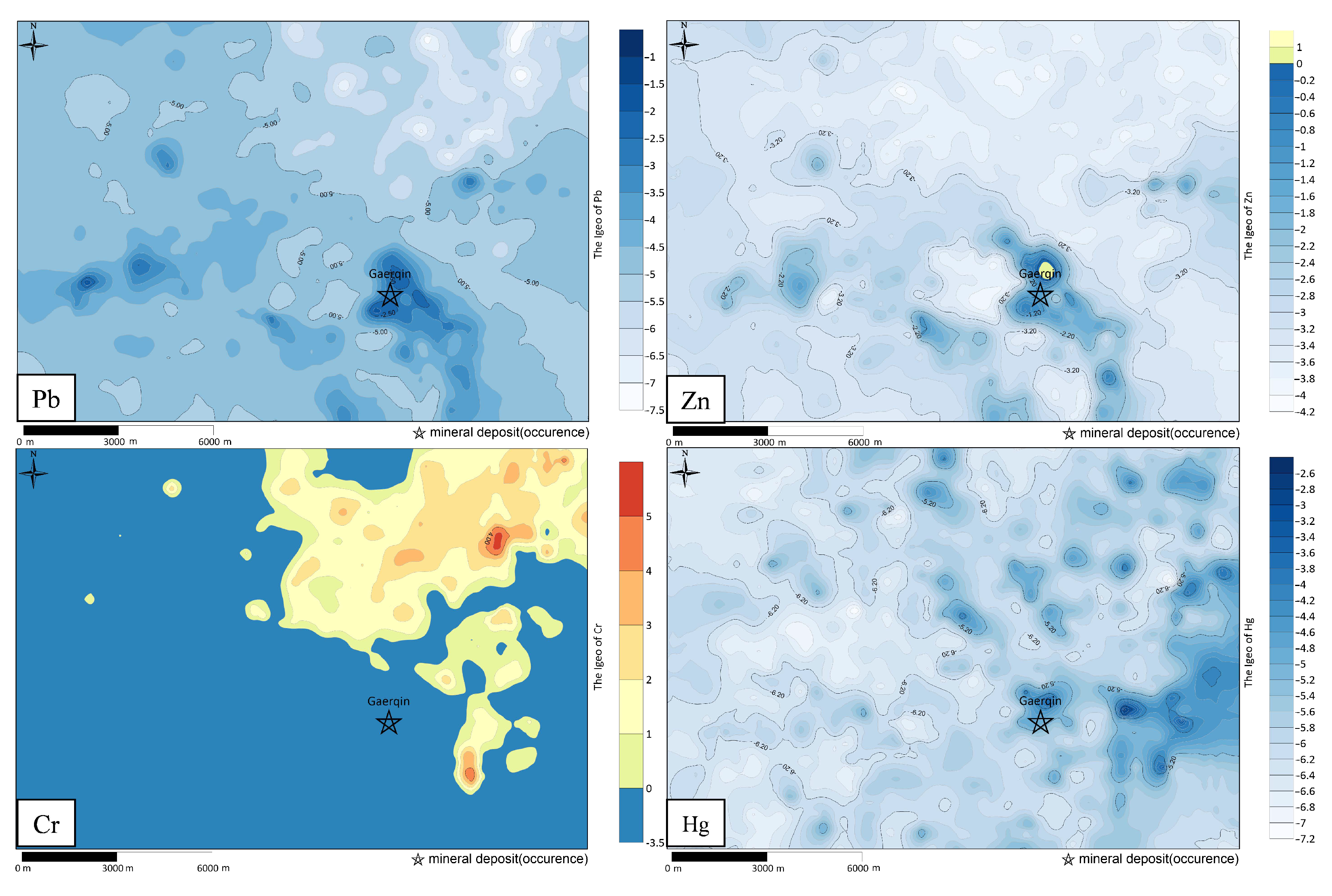
| Class | Value | Soil Quality |
|---|---|---|
| 0 | ≤ 0 | Practically uncontaminated |
| 1 | 0 < < 1 | Uncontaminated to moderately contaminated |
| 2 | 1 < < 2 | Moderately contaminated |
| 3 | 2 < < 3 | Moderately to heavily contaminated |
| 4 | 3 < < 4 | Heavily contaminated |
| 5 | 4 < < 5 | Heavily to extremely contaminated |
| 6 | 5 < | Extremely contaminated |
| Er | Single-Potential Ecological Risk (Er) | RI | Comprehensive Potential Ecological Risk (RI) |
|---|---|---|---|
| <40 | Low potential ecological risk | <90 | Low potential ecological risk |
| 40 ≤ Er < 80 | Moderate potential risk | 90 ≤ RI < 180 | Moderate potential ecological risk |
| 80 ≤ Er < 160 | Considerable potential risk | 180 ≤ RI < 360 | Strong potential ecological risk |
| 160 ≤ Er < 320 | High potential risk | 360 ≤ RI < 720 | Very strong potential |
| ≥320 | Significantly very high | ≥720 | Highly strong potential |
| Class | Appraisal Result | Appraisal Result | ||
| 1 | < 1 | Non-pollution | ≤ 0.7 | Safety domain |
| 2 | 1 ≤ < 2 | Mild pollution | 0.7 < ≤ 1 | Precaution domain |
| 3 | 2 ≤ < 5 | Moderate pollution | 1 < ≤ 2 | Slightly polluted domain |
| 4 | > 5 | Heavy pollution | 2 < ≤ 3 | Moderately polluted domain |
| 5 | - | - | > 3 | Seriously polluted domain |
| Original Data | Calculated Data | ||||||||
|---|---|---|---|---|---|---|---|---|---|
| Variables | Min | Mean | Max | SD | Variables | Min | Mean | Max | SD |
| Pb | 3.15 | 30.64 | 361.86 | 26.34 | Pb Igeo | −4.84 | −7.9 | −1.05 | 0.72 |
| Zn | 38.25 | 98.05 | 1631.15 | 84.27 | Zn Igeo | −3.12 | −4.29 | 1.12 | 0.61 |
| Cr | 45.22 | 683.57 | 25751.6 | 1888.75 | Cr Igeo | −1.05 | −3.31 | 5.84 | 1.9 |
| Hg | 0.01 | 0.04 | 0.52 | 0.03 | Hg Igeo | −5.94 | −7.49 | −2.12 | 0.62 |
Publisher’s Note: MDPI stays neutral with regard to jurisdictional claims in published maps and institutional affiliations. |
© 2021 by the authors. Licensee MDPI, Basel, Switzerland. This article is an open access article distributed under the terms and conditions of the Creative Commons Attribution (CC BY) license (http://creativecommons.org/licenses/by/4.0/).
Share and Cite
Liu, Q.; Liu, G.; Chen, W.; Chen, G. HMCA-Contour: A Visual Basic Program Based on Surfer Automation for Soil Heavy Metal Spatial Distribution and Contamination Assessment Mapping. Sustainability 2021, 13, 2282. https://doi.org/10.3390/su13042282
Liu Q, Liu G, Chen W, Chen G. HMCA-Contour: A Visual Basic Program Based on Surfer Automation for Soil Heavy Metal Spatial Distribution and Contamination Assessment Mapping. Sustainability. 2021; 13(4):2282. https://doi.org/10.3390/su13042282
Chicago/Turabian StyleLiu, Qingping, Guannan Liu, Wei Chen, and Guoliang Chen. 2021. "HMCA-Contour: A Visual Basic Program Based on Surfer Automation for Soil Heavy Metal Spatial Distribution and Contamination Assessment Mapping" Sustainability 13, no. 4: 2282. https://doi.org/10.3390/su13042282
APA StyleLiu, Q., Liu, G., Chen, W., & Chen, G. (2021). HMCA-Contour: A Visual Basic Program Based on Surfer Automation for Soil Heavy Metal Spatial Distribution and Contamination Assessment Mapping. Sustainability, 13(4), 2282. https://doi.org/10.3390/su13042282







